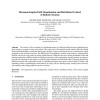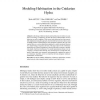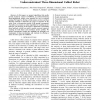86 search results - page 12 / 18 » Quantum Mechanical Model of Emotional Robot Behaviors |
73
Voted
IROS
2006
IEEE
15 years 6 months ago
2006
IEEE
- In this paper, we seek to understand how leg muscles and tendons work mechanically during walking in order to motivate the design of efficient robotic legs. We hypothesize that a...
105
click to vote
CIBCB
2006
IEEE
15 years 6 months ago
2006
IEEE
Abstract— Quantum mechanics and molecular dynamic simulation provide important insights into structural configurations and molecular interaction data today. To extend this atomi...
115
click to vote
AROBOTS
2004
15 years 7 days ago
2004
The control of robot swarming in a distributed manner is a difficult problem because global behaviors must emerge as a result of many local actions. This paper uses a bio-inspired ...
SCAI
2008
15 years 1 months ago
2008
Abstract. In the design of behavior-based control architectures for robots it is common to use biology as inspiration, and often the observed functionalities of insect behaviors ar...
62
Voted
IROS
2007
IEEE
15 years 6 months ago
2007
IEEE
— In this paper we present algorithms that enable precise trajectory control of NIMS3D, an underconstrained, three-dimensional cabled robot intended for use in actuated sensing. ...



